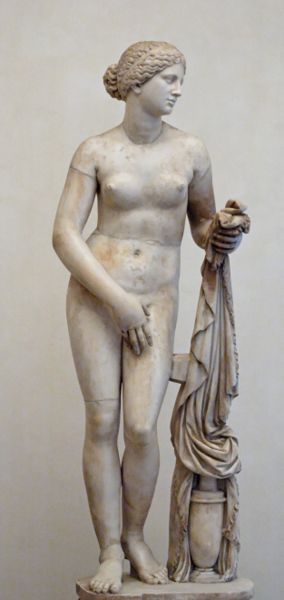Introduction to Aphrodite
The Greek goddess of love and beauty was Aphrodite. Her Roman counterpart was Venus. Today’s culture depicits Aphrodite as a goddess of petty desires, but she was much more than that. Yes, she had a part in sexual love and desires, but she was also involved in affection and all the impulses that deal with everyday life. Legend has that Aphrodite could make any man fall in love with her just by them simply laying their eyes on her. It is said that Aphrodite was born from the sea foam near Paphos, Cyprus. Aphrodite was born not as an infant according to every image and reference that is made to her. She is referred to as a grown woman who was instantly desirable. Aphrodite’s ability to seduce was so great, that every god wanted her for their wife, even the mighty Zeus. Aphrodite felt she was too good for any of her suitors and rejected every one of them. As her punishment, Zeus made her the wife of a very homely and lame Hephaestus who was a smith-god. But this did not stop Aphrodite, she was unfaithful to her husband and had many affairs with gods and mortals. Aphrodite had many worshipers and during her festival the Aphrodisiac it was considered a form of worship to have sexual intercourse with her priestesses that some refer to as sacred prostitutes.

Left is the Aphrodite of Knidos sculpted by Praxiteles in the fourth century BC. This is the statue that set the standard for future female nudes.
Photo credit: http://z.about.com/d/ancienthistory/1/0/B/b/2/284px-Cnidus_Aphrodite_Altemps_Inv8619.jpg
An iconic piece of Western art is a marble statue known as the Aphrodite of Melos, or Venus de Milo (right). It is possible one of the most recognizable pieces of art from the ancient world. The famous missing arms could have something to do with that. The statue was created during the Hellenistic period and has such details that could only be Hellenistic bravado. Such as the drapery that is twisted around Aphrodite’s hips and legs. Today, this statue continues to capture the attention of audiences with her eternal beauty. You can see this beautiful piece of art at the Musee du Louvre, Paris.
Photo credit: http://www.cs.utah.edu/~wyman/personal/europe2003/ParisLouvreVenusDeMilo.jpg
Ready to explore?
- Introduction to Aphrodite
- Corinth
- Aphrodisias
- Knidos
- Paphos
- Bibliography
- Guestbook
- Home